

The Joy of a Phone-Free School: How Our Students Thrive Without Screens
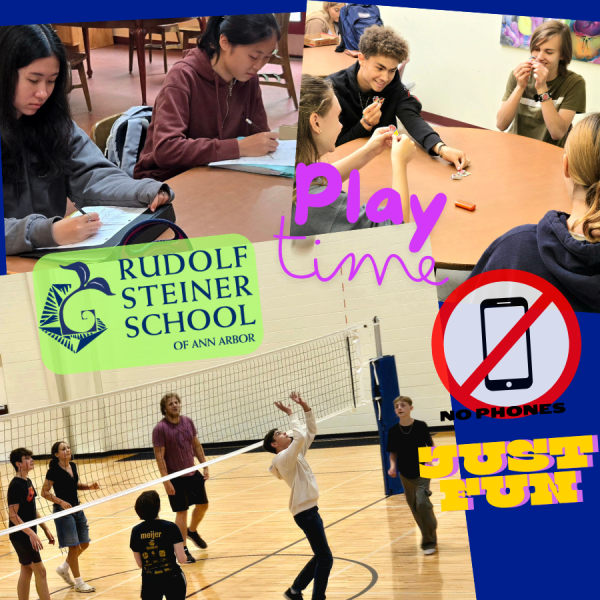
The Joy of a Phone-Free School: How Our Students Thrive Without Screens
Imagine a typical school day where students, between classes and during breaks, are glued to their smartphones—scrolling through social media, playing games, or texting. Conversations are sparse, eye contact is minimal, and the vibrant energy of youthful interaction seems subdued. Now, contrast this with a school environment where smartphones are set aside: students engage in lively face-to-face discussions, participate in spontaneous games, and immerse themselves fully in classroom activities without the constant pull of notifications. This is the reality we’ve cultivated at Rudolf Steiner School of Ann Arbor, embracing a phone-free policy that fosters genuine connections and holistic development.
The Deeper Engagement of Phone-Free Education
At our school, we’ve observed that removing smartphones from the school day does more than just eliminate distractions—it rekindles a deeper, more meaningful engagement among students. Freed from screens, students rediscover the joy of direct communication, collaborative problem-solving, and hands-on learning. This environment aligns seamlessly with the principles of Waldorf education, emphasizing experiential learning and nurturing the whole child.
We Are Phone-Free, Not Tech-Free
While our school maintains a phone-free environment during school hours, we are not devoid of technology. In fact, our curriculum incorporates technology in age-appropriate ways to ensure students are prepared for the digital world:
• Middle School: Students are introduced to computers and the internet in an intentional way that supports learning. Additionally, our middle school robotics club fosters interest in technology and engineering through hands-on projects. https://www.steinerschool.org/programs/extracurricular-activities.cfm
• High School: Our state-of-the-art computer lab facilitates courses in coding, digital literacy, and other computer science subjects. We also have an active high school robotics club where students collaborate on competitive projects that develop real-world problem-solving skills. https://www.steinerschool.org/about-us/waldorf-education.cfm
Many of our graduates go on to thrive in technology fields, excelling in computer science, engineering, and data analysis. Research shows that Waldorf graduates develop strong interdisciplinary thinking skills that prepare them for success in fields that require both creativity and technical expertise.
Leading the Way in Ann Arbor
Our commitment to a phone-free school day positions us as pioneers in the Ann Arbor educational community. While some other local schools have implemented partial restrictions, our comprehensive approach ensures that students remain unplugged throughout the day—including breaks and transitions between classes.
Several Ann Arbor schools are recognizing the value of limiting phone use:
• Forsythe Middle School and Tappan Middle School both require students to keep phones in lockers during school hours. https://forsythe.a2schools.org/our-school/cell-phone-policy, https://tappan.a2schools.org/our-school/cell-phone-policy
• Huron High School has introduced classroom phone storage policies in its Mathematics and English departments to help students stay focused. https://thehuronemery.com/9731/news/cell-phone-use-teacher-led-procedures-to-enrich-student-experience/
The Transformative Power of Disconnecting
The shift to a phone-free environment has yielded profound benefits:
• Enhanced Academic Focus: Without the allure of smartphones, students engage more deeply in lessons, leading to improved comprehension and retention.
• Strengthened Social Bonds: Face-to-face interactions during breaks and collaborative projects foster authentic relationships and empathy among students.
• Improved Mental Well-being: Reducing screen time has been linked to decreased anxiety and stress, allowing students to be more present and mindful.
Embracing a Connected Future Without Phones
As more schools recognize the value of limiting smartphone use, it’s evident that this movement is not about restricting technology but about reclaiming the essence of human connection and focused learning. By leading the way in this initiative, Rudolf Steiner School of Ann Arbor not only adheres to the foundational principles of Waldorf education but also prepares students for careers in STEM, the arts, and beyond.
We invite families seeking a nurturing, distraction-free educational environment to join us in this journey, where students can truly engage with the world around them and develop into well-rounded individuals.
Explore the experiences of other schools with phone-free policies:
• “New data reveals shocking trend since school mobile phone ban”
- “The big smartphone school experiment”
https://www.thetimes.co.uk/article/inside-schools-ban-smartphones-6knb8qtfc
- “Cell phones hinder classroom learning. Texas should tell school districts to lock them up”
- "Waldorf Schools are Media Literacy Role Models"
https://www.steinerschool.org/about-us/waldorf-schools-are-media-literacy-role-models/
History Through Architecture
History through Architecture is a culminating course in the K-12 journey of Waldorf Education. It is a sweeping survey that traces the development of human consciousness over millennia from the earliest times to the present, including speculations about what the future may hold for our collective lives on Earth. Through this year’s special block, our 12th Graders explored their unique places in the long line of other human beings who have come before them. They began to see themselves with new eyes as they related to the larger human story.
The vehicle for their experience is what we call Architecture…a kind of “memory chip” that holds a rich tapestry of data points logged from all aspects of humanity – iconic facets that have imbued the “bricks-and-mortar” of buildings, cities, landscapes and human-made systems with the zeitgeist or spirit of the age in which they were manifested. Specific teachings in this block have been artfully designed to showcase how human ingenuity advanced with each succeeding generation. New ideas imaginatively evolved to produce structures, materials, energy and metaphysical awareness that created all our structures from simple barrow mounds of earliest human settlements to the soaring skyscrapers of our modern world. All of them imbued with an inner force – a seeking for higher awareness – what we term today a “spiritual experience”.
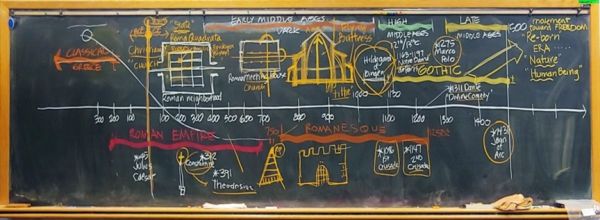
Colorful, hand-drawn chalkboards of chronological, step-by-step timelines showed how passive and dynamic forces of compression and tension moved across time to shape clay, stone, brick, metal, glass and myriad other materials and processes into the infinitely varied forms that we see in our material world. Concepts of “boundary” and “monument” drove the construction of fences, walls for protection from weather and wild animals, but also marked personal identity – whether for an individual or for tribes and clans, where the “I” became a “we”.
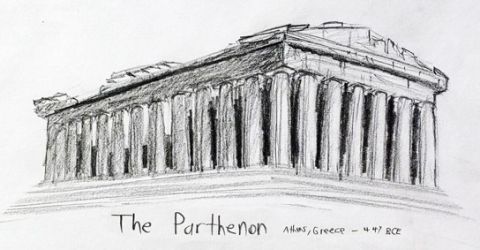 The students hand drew and wrote the salient points of the block into their Main Lesson books. Applying their innate Creativity and Imagination, they recorded the content of their learning. Some exercises were given to demonstrate how historic structures could be shown in plan, section and in three dimensions for learning how buildings are represented.
The students hand drew and wrote the salient points of the block into their Main Lesson books. Applying their innate Creativity and Imagination, they recorded the content of their learning. Some exercises were given to demonstrate how historic structures could be shown in plan, section and in three dimensions for learning how buildings are represented.
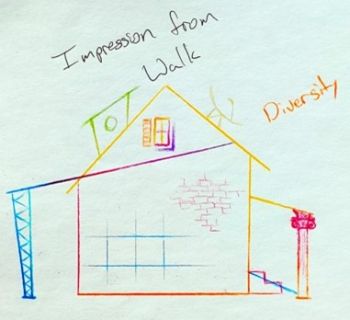 Other exercises engage the students’ personal observations and imaginations. For example, an “Impression/Expression” exercise was assigned for an outside walk taken through the Pontiac Trail neighborhood during one class period. Each student observed a particular perception along the way (a house, a tree, the rhythm of structures, a door or window detail, etc.) that impressed them. Returning to school, some form of expression was made from memory that described the nature of the student’s experience.
Other exercises engage the students’ personal observations and imaginations. For example, an “Impression/Expression” exercise was assigned for an outside walk taken through the Pontiac Trail neighborhood during one class period. Each student observed a particular perception along the way (a house, a tree, the rhythm of structures, a door or window detail, etc.) that impressed them. Returning to school, some form of expression was made from memory that described the nature of the student’s experience.
We contrasted challenging Thinking of the block’s first week with a Clay Handwork exercise that explored the curved line under the force of compression that freed the student’s imagination.
In the second week, Wooden Sticks Handwork created a new experience reflecting the advent of the straight-line forces of tension in history that led to developing open-structured trusses.
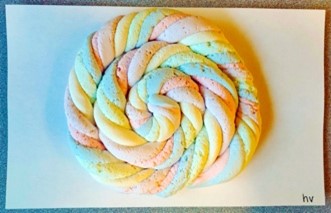
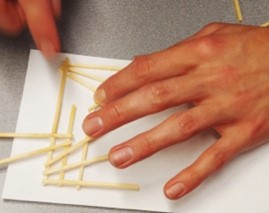
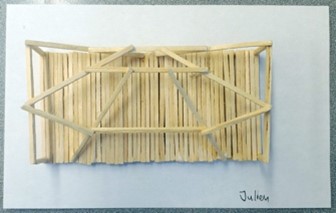
Toward the end of the block, after experiencing the great diversity of human structures built throughout history, students were given a final project where they were asked to design their own “architecture”. The day the assignment was given, this year’s Seniors immediately jumped into action, eagerly discussing possibilities and ideas for their individual or group to develop.
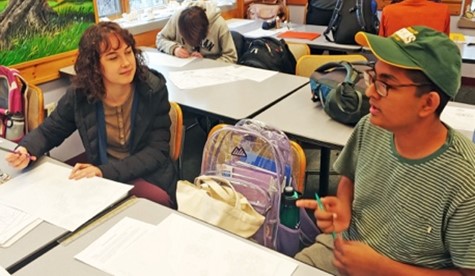 Over several days, students collaborated, talking and sketching ideas until a final design became clear. Every student prepared a statement, drawings, or a model to describe their vision. They then stood before their classmates and presented unique designs which inspired thoughtful questions and comments. This process of inner creativity - manifesting into outer forms -teaches lessons that will serve our Seniors as they venture out into the wider world to pursue their dreams in coming years.
Over several days, students collaborated, talking and sketching ideas until a final design became clear. Every student prepared a statement, drawings, or a model to describe their vision. They then stood before their classmates and presented unique designs which inspired thoughtful questions and comments. This process of inner creativity - manifesting into outer forms -teaches lessons that will serve our Seniors as they venture out into the wider world to pursue their dreams in coming years.
It is a great joy for me to witness the various revelations that unfold through each 12th Grader as they come to know themselves more deeply in the History through Architecture block.
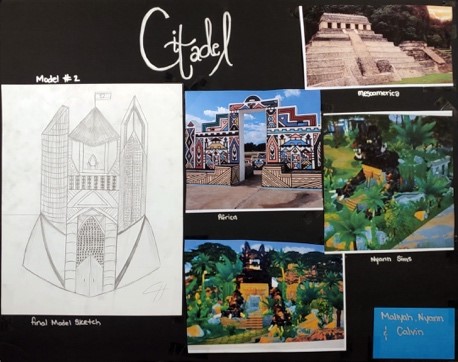
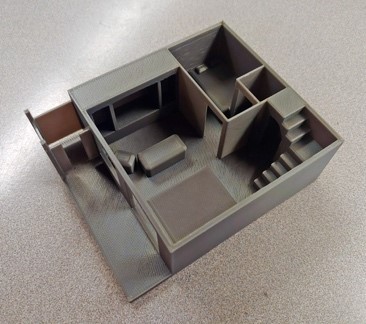
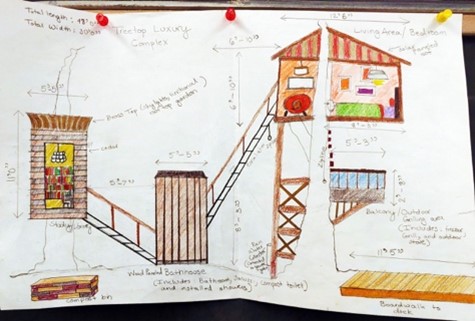
A Beautiful Experiment (Italy Part 2)
A beautiful experiment: 17 high school seniors, 5 teachers, and Venice, the floating city. Ms. Efimova, our high school art teacher, had the original idea, an “art trip…with sketchbooks.” After nearly a year of preparation, our plane left Detroit Metro Airport for Venice. It was March, 2001. Twenty trips later, the Italian Journey has become a cherished tradition for the seniors at Rudolf Steiner High School. Spring arrives in Italy, and our Italian friends wait impatiently for us to arrive. They deeply appreciate our students’ joyful laughter, heartfelt curiosity about Italy, thoughtfulness, kindness, singing, and gorgeous drawings. One of our guides has said, “No one on earth travels like this school”. It is true. We are not tourists at all, but thinkers and artists open to the possibility of surprising transformations. In a way, the experiment continues, with amazing results year after year.
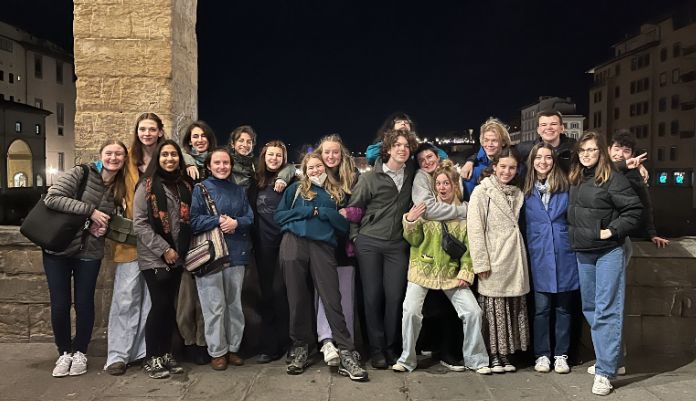
No one on earth travels like this school.
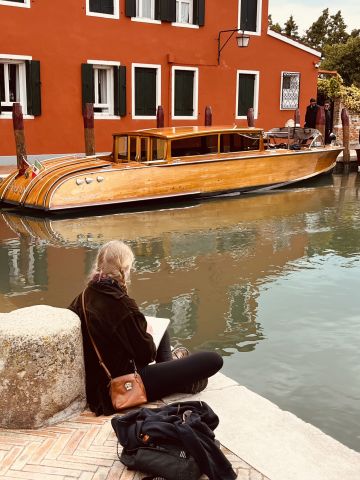 Venice, Florence, and Rome are our three muses now, with, when possible, the sweet addition of Orvieto, Lucca, Fiesole, Verona, or Vatican City. We begin in Venice. It is impossible to imagine this most improbable of cities until we sit in the rocking boat which takes us to the main islands of Venice. Arriving by sea has been the custom for about 1500 years. We disembark and the students gasp. “It is unreal!” “The buildings are older than a forest!” “There are no cars, and I hear just the water!” “It is a dream.” The changing colors and the continual movement of the water are mesmerizing, “quasi una fantasia”, almost like a fantasy. That’s the tempo marking for Beethoven’s “Moonlight Sonata”. If you cannot fly to Venice right this moment, try listening to that well-known piece. It will comfort you! This is the city married to the sea, but also the city where Galileo demonstrated his telescope for the Doge from the top of the bell tower. Optics and acoustics. A Scientific Revolution on the way.
Venice, Florence, and Rome are our three muses now, with, when possible, the sweet addition of Orvieto, Lucca, Fiesole, Verona, or Vatican City. We begin in Venice. It is impossible to imagine this most improbable of cities until we sit in the rocking boat which takes us to the main islands of Venice. Arriving by sea has been the custom for about 1500 years. We disembark and the students gasp. “It is unreal!” “The buildings are older than a forest!” “There are no cars, and I hear just the water!” “It is a dream.” The changing colors and the continual movement of the water are mesmerizing, “quasi una fantasia”, almost like a fantasy. That’s the tempo marking for Beethoven’s “Moonlight Sonata”. If you cannot fly to Venice right this moment, try listening to that well-known piece. It will comfort you! This is the city married to the sea, but also the city where Galileo demonstrated his telescope for the Doge from the top of the bell tower. Optics and acoustics. A Scientific Revolution on the way.
Quasi una fantasia.
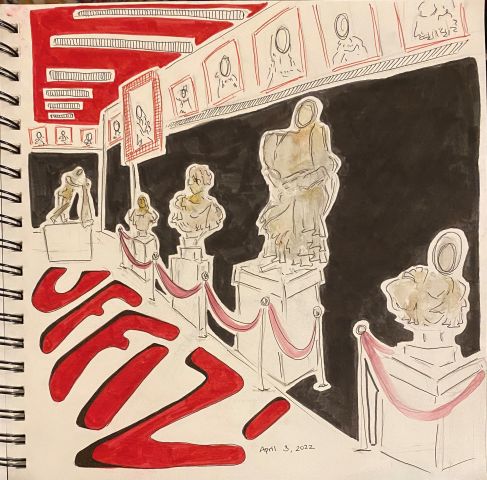 Water gives way to solid ground. We arrive in Florence, a city of prose and poetry, individualism and competition, science and art, dark buildings and sun-drenched courtyards. An Italian proverb states that spring has arrived “when you can step on nine daisies at once.” At the convent that has been our home in Florence these many years, we are greeted by both the nuns, and the garden daisies. Within moments, our students are weaving garlands for their hair. Then to sketch Michelangelo’s “David”! We walk in his footsteps, and Dante’s, and Brunelleschi’s, and Leonardo’s and again, Galileo’s. Academic lessons happens in tiny bursts. Here is the corner where Michelangelo and Leonardo argued, there is Dante’s street, that’s where Botticelli burned his paintings (fortunately not all of them). The intrigue, the excitement, the stupendous discoveries of Renaissance Florentines continue to resound. The cast of characters has changed, but the stage sets are all still there.
Water gives way to solid ground. We arrive in Florence, a city of prose and poetry, individualism and competition, science and art, dark buildings and sun-drenched courtyards. An Italian proverb states that spring has arrived “when you can step on nine daisies at once.” At the convent that has been our home in Florence these many years, we are greeted by both the nuns, and the garden daisies. Within moments, our students are weaving garlands for their hair. Then to sketch Michelangelo’s “David”! We walk in his footsteps, and Dante’s, and Brunelleschi’s, and Leonardo’s and again, Galileo’s. Academic lessons happens in tiny bursts. Here is the corner where Michelangelo and Leonardo argued, there is Dante’s street, that’s where Botticelli burned his paintings (fortunately not all of them). The intrigue, the excitement, the stupendous discoveries of Renaissance Florentines continue to resound. The cast of characters has changed, but the stage sets are all still there.
Grand Finale! Urbs Aeterna: The Eternal City. Rome! The scale is immense. The architecture, in ruins or intact, is magnificent, the vistas are glorious. Mosaic, paint, marble, bronze, gold, and ancient, perfect, concrete compete for our attention. Archeological work is everywhere. After all, 80% of Rome is still buried underground, and someone must dig it up! This city is modern and ancient and medieval and Renaissance and Baroque all at once. How can we make sense of it? Our beloved guide weaves a tapestry of stories while we walk together. She does it so wonderfully that sometimes we cry. Her stories are timed to our steps through the streets. It is her unique form of choreography. Genius, truly. We are enriched and at home. She has given us the keys to the city.
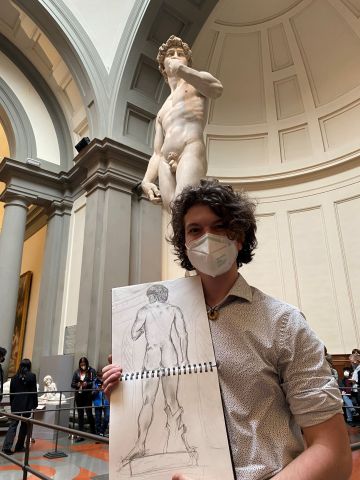 Our Italian Journey comes to a close for another year. Almost 450 students and teachers have traveled to Italy with Rudolf Steiner High School. Every single one has left an imprint. All have strong memories, sketchbooks and a connection with the world and each other that cannot be created in the classroom alone. We're honored to be able to offer this unique experience to our students and grateful to all who have been a part of it. Grazie Mille! Deepest thanks to all who have made this beautiful idea an even more beautiful reality!
Our Italian Journey comes to a close for another year. Almost 450 students and teachers have traveled to Italy with Rudolf Steiner High School. Every single one has left an imprint. All have strong memories, sketchbooks and a connection with the world and each other that cannot be created in the classroom alone. We're honored to be able to offer this unique experience to our students and grateful to all who have been a part of it. Grazie Mille! Deepest thanks to all who have made this beautiful idea an even more beautiful reality!
(We'd like to express our regret to the classes of 2020 and 2021 who, due to the pandemic, were unable to experience Italy in this way.)
Please Enjoy Our YouTube Video
Arts, Advocacy & Recognition by the Library of Congress
Working to rebuild community and identity in the aftermath of the Vietnam War.
Bryan Thao Worra is a talented Laotian American writer, poet and community activist and has forged a path connecting experiences of refugees with the restorative aspects of writing. Born in Vientiane in the Kingdom of Laos, Bryan was adopted at three days old by an American pilot named John Worra, who flew for Royal Air Lao. He arrived in the U.S. six months later and eventually settled with his family in Saline, Michigan. He joined the Rudolf Steiner Lower School in it’s fledgling years (early 1980’s), when the school had mixed grades and only two classrooms. After graduating from 8th grade at RSSAA in 1987, he went on to Saline High School and eventually Otterbein College.
Bryan’s leadership in the writing community is being acknowledged during a livestreamed event at the Library of Congress on May 2 in recognition of Asian American and Pacific Islander Heritage month. Appreciating his accomplishments, we reached out to him in order to learn a little about his thoughts on his Waldorf education and ideas around the arts and advocacy.
Your work over the last 20 years has focused on refugee resettlement and the arts. Can you tell us how you’ve connected with refugees through your writings and Southeast Asian diaspora?
The last two decades have taken me across the globe, searching for others who were scattered in the diaspora that followed the end of the Southeast Asian conflicts of the 20th century. I'd understood that many of the elders who were so fundamental to understanding how and why we are in America were passing away even as the younger generation didn't always know how to ask the questions they needed to preserve their family and community histories. In the United States, and in many parts of the world, those who don't understand their roots are often among the most easily exploited and many will find themselves adrift if they cannot understand who they have been, and how to express a future they see themselves in.
One aspect of my process has involved committing to a range of stories, poems, artworks and presentations on both the historical and the wildly imaginative, the cosmic and the everyday and to encourage my fellow refugees to consider different ways of expressing their own experiences and dreams. To give them the freedom to feel that it's ok to risk and to write more than one story, one poem, one idea to pass on to the next generation.
You joined RSSAA as a very young person. What do you remember about your experience with Waldorf education that has shaped your poetry and writing, or you as a person?
At first it was a startling experience, but a wonderful challenge engaging both my logical and creative sides. Our teachers there helped me find the confidence and initiative to direct my own learning and response to given lessons. One of the most important parts of that experience was creating my own textbooks. That absolutely impacted how I eventually made chapbooks and poetry collections later, and my enthusiasm for having experience on all sides of the publishing process. RSSAA prepared me for high school and college in such a way that I often felt way ahead of my peers and even a little out of place, enthusiastically seeking knowledge and ideas to share with others. It was always surprising to meet others who didn't have that energy and motivation. My years with RSSAA encouraged me to form lifelong friendships and to explore the deep connections between everything and to see my own experiences had a relationship to it all.
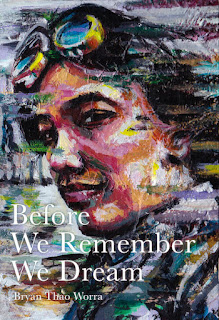 What role did the arts play for you as you grew up?
What role did the arts play for you as you grew up?
Growing up there weren't many books about my culture and my heritage in the encyclopedias or in popular culture. There was no clear timeline that helped me understand those essential questions: "Who am I? Where do I come from? Why am I here? Where are we going?" The arts provided a way to risk, and to experiment, to pose questions. They weren't legal depositions, but could often touch on great truths while I explored the questions of my identity and what it might mean to reconnect with others to rebuild our community after the war. Initially this was often a rather non-linear process but it became essential, much like the process in solving a jigsaw puzzle.
Do you have advice for young people who want to pair the arts with advocacy?
There are many ways to articulate a vision for a better world. Sometimes by showing a new model of possibilities, sometimes through warnings of unintended or even intended consequences. Each technique has its uses and limitations, and an artist will always face a particular risk with advocacy: Do we reinforce the existing arguments or dismantle them for something better? Pushback is possible with both. We have to commit to learning as much as we can on a given issue, and then we have to give ourselves permission to risk a new way of expressing what matters to us. And sometimes, an artist must find ways to avoid the inertia that comes from waiting for "the perfect" and instead seek "the good" and "the necessary" at a given point of time. As you get started, the key thing to remember is that you don't need to be the last word, but a word that gets the conversations started to create change.
